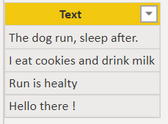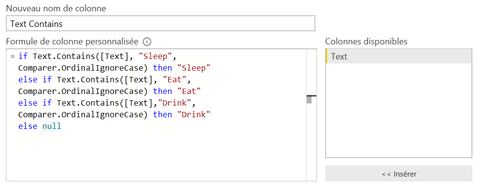- Power BI forums
- Updates
- News & Announcements
- Get Help with Power BI
- Desktop
- Service
- Report Server
- Power Query
- Mobile Apps
- Developer
- DAX Commands and Tips
- Custom Visuals Development Discussion
- Health and Life Sciences
- Power BI Spanish forums
- Translated Spanish Desktop
- Power Platform Integration - Better Together!
- Power Platform Integrations (Read-only)
- Power Platform and Dynamics 365 Integrations (Read-only)
- Training and Consulting
- Instructor Led Training
- Dashboard in a Day for Women, by Women
- Galleries
- Community Connections & How-To Videos
- COVID-19 Data Stories Gallery
- Themes Gallery
- Data Stories Gallery
- R Script Showcase
- Webinars and Video Gallery
- Quick Measures Gallery
- 2021 MSBizAppsSummit Gallery
- 2020 MSBizAppsSummit Gallery
- 2019 MSBizAppsSummit Gallery
- Events
- Ideas
- Custom Visuals Ideas
- Issues
- Issues
- Events
- Upcoming Events
- Community Blog
- Power BI Community Blog
- Custom Visuals Community Blog
- Community Support
- Community Accounts & Registration
- Using the Community
- Community Feedback
Register now to learn Fabric in free live sessions led by the best Microsoft experts. From Apr 16 to May 9, in English and Spanish.
- Power BI forums
- Forums
- Get Help with Power BI
- Power Query
- Re: Find values from one table in the text of anot...
- Subscribe to RSS Feed
- Mark Topic as New
- Mark Topic as Read
- Float this Topic for Current User
- Bookmark
- Subscribe
- Printer Friendly Page
- Mark as New
- Bookmark
- Subscribe
- Mute
- Subscribe to RSS Feed
- Permalink
- Report Inappropriate Content
Find values from one table in the text of another table with the Query Editor
Hi community, can you help me ?
I'm looking to find the words in one table in the text of another table.
I want a new column in the table "Table Text" that would contain all the "Keys" found in the "Text".
I tired the "Text.Contains" but I don't know how to replace "Sleep", "Eat", "Drink" by the column name "Keys" of the table "Table Keys" and I want all the "Keys" in the "Text", not the first "Keys" found :
So I tried with a formula found on the forum :
(let word = [Text Contains] in Table.SelectRows(#"Table Keys", each [Keys] = word)){0}[Keys]
But it doesn't work if I try to replace "[Text Contains]" by "[Text]".
I tired to combine this fomula with Text.Contains but I failed.
The result I'm looking for should look something like this :
I would just split the column with the corresponding separator then.
Thanks !
Solved! Go to Solution.
- Mark as New
- Bookmark
- Subscribe
- Mute
- Subscribe to RSS Feed
- Permalink
- Report Inappropriate Content
Hello @Fabi
I've prepared a solution for you. This query contains both tables in one query. This solution is quite specific and therefore not be rebuild using only the UI. Here the solution
let
Keys = #table
(
{"Keys"},
{ {"Eat"}, {"Drink"}, {"Run"}, {"Sleep"} }
),
Text = #table
(
{"Text"},
{ {"The dog run, sleep after."}, {"I eat coockies and drink milk"}, {"Run is healthy"}, {"Hello there !"} }
),
AddList = Table.AddColumn
(
Text,
"Custom",
each List.Select
(
Keys[Keys
],
(
sel
)=>
Text.Contains
(
Text.Lower
(
[Text]
),
Text.Lower
(
sel
)
)
)
),
Extracted = Table.TransformColumns
(
AddList,
{"Custom", each Text.Combine(List.Transform(_, Text.From), ", "), type text}
)
in
Extracted
Copy paste this code to the advanced editor in a new blank query to see how the solution works. If this solution fits your need, copy and past a part of it and implement it in your query
If this post helps or solves your problem, please mark it as solution (to help other users find useful content and to acknowledge the work of users that helped you)
Kudoes are nice too
Have fun
Jimmy
- Mark as New
- Bookmark
- Subscribe
- Mute
- Subscribe to RSS Feed
- Permalink
- Report Inappropriate Content
Hello @Fabi
I've prepared a solution for you. This query contains both tables in one query. This solution is quite specific and therefore not be rebuild using only the UI. Here the solution
let
Keys = #table
(
{"Keys"},
{ {"Eat"}, {"Drink"}, {"Run"}, {"Sleep"} }
),
Text = #table
(
{"Text"},
{ {"The dog run, sleep after."}, {"I eat coockies and drink milk"}, {"Run is healthy"}, {"Hello there !"} }
),
AddList = Table.AddColumn
(
Text,
"Custom",
each List.Select
(
Keys[Keys
],
(
sel
)=>
Text.Contains
(
Text.Lower
(
[Text]
),
Text.Lower
(
sel
)
)
)
),
Extracted = Table.TransformColumns
(
AddList,
{"Custom", each Text.Combine(List.Transform(_, Text.From), ", "), type text}
)
in
Extracted
Copy paste this code to the advanced editor in a new blank query to see how the solution works. If this solution fits your need, copy and past a part of it and implement it in your query
If this post helps or solves your problem, please mark it as solution (to help other users find useful content and to acknowledge the work of users that helped you)
Kudoes are nice too
Have fun
Jimmy
- Mark as New
- Bookmark
- Subscribe
- Mute
- Subscribe to RSS Feed
- Permalink
- Report Inappropriate Content
Thank @Jimmy801 ,
But I forgot to say that this is just an example in this post. In fact, I work with different tables, one that contains more than 200 keys and another that contains thousands of columns of text that will be more and more numerous with each update of the data. It would be very long and tiring to write all the keys and texts in the code.
- Mark as New
- Bookmark
- Subscribe
- Mute
- Subscribe to RSS Feed
- Permalink
- Report Inappropriate Content
Hello @Fabi
no, my solution is only to show you how to achieve your goal..
you can copy paste it to the editor and checking how it works and if this fits your needs
This said you have to use my query and implement in your environment, replacing my tables with yours (the keys with an external one, the other one with the table output of your main query)
Bye
Jimmy
- Mark as New
- Bookmark
- Subscribe
- Mute
- Subscribe to RSS Feed
- Permalink
- Report Inappropriate Content
It works !
For beginners like me who would fall on this post : I just replaced
let
Keys = #table
(
{"Keys"},
{ {"Eat"}, {"Drink"}, {"Run"}, {"Sleep"} }
),
Text = #table
(
{"Text"},
{ {"The dog run, sleep after."}, {"I eat coockies and drink milk"}, {"Run is healthy"}, {"Hello there !"} }
),by
let
Keys = #"Table Keys",
Text = #"Table Text",
Sorry for not understanding the first time, I have been working with Power BI for 3 weeks, I do not have everything in mind yet.
Thank you so much @Jimmy801 .
- Mark as New
- Bookmark
- Subscribe
- Mute
- Subscribe to RSS Feed
- Permalink
- Report Inappropriate Content
Helpful resources

Microsoft Fabric Learn Together
Covering the world! 9:00-10:30 AM Sydney, 4:00-5:30 PM CET (Paris/Berlin), 7:00-8:30 PM Mexico City

Power BI Monthly Update - April 2024
Check out the April 2024 Power BI update to learn about new features.








